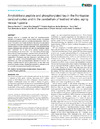Please use this identifier to cite or link to this item:
https://accedacris.ulpgc.es/jspui/handle/10553/77718
| Título: | Amyloid-beta peptide and phosphorylated tau in the frontopolar cerebral cortex and in the cerebellum of toothed whales: aging versus hypoxia | Autores/as: | Sacchini, Simona Diaz Delgado, Josue Espinosa De Los Monteros Y Zayas, Antonio Paz Sanchez, Yania Bernaldo De Quirós Miranda, Yara Sierra Pulpillo, Eva María Arbelo Hernández, Manuel Antonio Herráez Thomas, Pedro Manuel Fernández Rodríguez, Antonio Jesús |
Clasificación UNESCO: | 310907 Patología 3105 Peces y fauna silvestre |
Palabras clave: | Beaked whales Hypoxia Beta amyloid Phosphorylated tau Toothed whales |
Fecha de publicación: | 2020 | Proyectos: | Patologia Embolica (Gaseosa/Grasa) en Cetaceos (Pegcet-3) Patología Embólica (Gaseosa/Grasa) en Cetáceos |
Publicación seriada: | Biology Open | Resumen: | Hypoxia could be a possible risk factor for neurodegenerative alterations in cetaceans’ brain. Among toothed whales, the beaked whales are particularly cryptic and routinely dive deeper than 1000 m for about 1 h in order to hunt squids and fishes. Samples of frontal cerebral and cerebellar cortex were collected from nine animals, representing six different species of the suborder Odontoceti. Immunohistochemical analysis employed anti-β-amyloid (Aβ) and anti-neurofibrillary tangle (NFT) antibodies. Six of nine (67%) animals showed positive immunolabeling for Aβ and/or NFT. The most striking findings were intranuclear Aβ immunopositivity in cerebral cortical neurons and NFT immunopositivity in cerebellar Purkinje neurons with granulovacuolar degeneration. Aβ plaques were also observed in one elderly animal. Herein, we present immunohistopathological findings classic of Alzheimer's and other neurodegenerative diseases in humans. Our findings could be linked to hypoxic phenomena, as they were more extensive in beaked whales. Despite their adaptations, cetaceans could be vulnerable to sustained and repetitive brain hypoxia. | URI: | https://accedacris.ulpgc.es/handle/10553/77718 | ISSN: | 2046-6390 | DOI: | 10.1242/bio.054734 | Fuente: | Biology Open [E2046-6390], v. 9(11), bio054734 |
| Colección: | Artículos |
Citas de WEB OF SCIENCETM
Citations
15
actualizado el 08-jun-2025
Visitas
181
actualizado el 21-sep-2024
Descargas
129
actualizado el 21-sep-2024
Google ScholarTM
Verifica
Altmetric
Comparte
Exporta metadatos
Los elementos en ULPGC accedaCRIS están protegidos por derechos de autor con todos los derechos reservados, a menos que se indique lo contrario.
